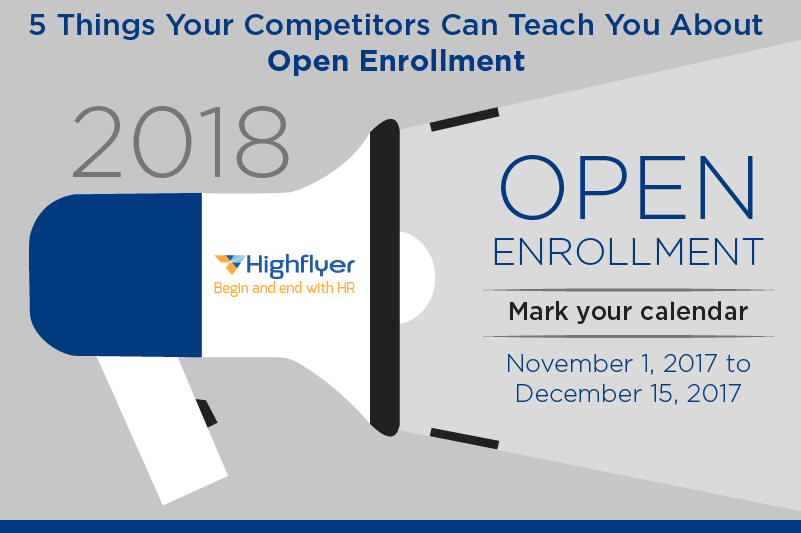
5 Things Your Competitors Can Teach You About Open Enrollment
Open Enrollment can be an overwhelming period for both employers and employees. The season brings brokers and HR professionals an annual administrative headache with stress factors of the options of new plans and shifts in the level of participation.
It is a good strategic move to monitor what is working for your competitors and adapt some of their methods and techniques to maximize your own performance and growth. Here are 5 things you can learn from your competitors about open enrollment.
1) Plan Ahead, Start Early
Communicate early & often – don’t bombard your clients with loads of information at one time. Provide them with the dates of Open Enrollment, an overview of changes, and what this means to them.
Communicate clearly – don’t make assumptions about how well everyone already understands their benefit plans. We fight an endless employee benefits battle with half of the effort towards finding ways to communicate offerings that are understandable and easy to grasp. Make difficult benefit decisions easier by keeping everything organized and easy to follow with tips, guides, and checklists. Use Open Enrollment as an opportunity to listen to your clients to see what they do and do not understand.
2) Don’t Rely on One Communication Strategy
Workplace demographics can be very diverse, with differing preferences. Not all participants are the same, and the benefits they require will differ. This diversity allows you to create more personalized and targeted messages. Tailor messages to specific plans while presenting in the clearest and simple format. Create a 1-page ‘Quick Guide’ for your clients outlining the benefits and disadvantages of each plan option providing a clear insight into advantages, costs, and expectations.
Participants learn differently and at various speeds. They have their own preferences of how to receive communication. Deliver messages through different types of communication channels (email, social media, text messages, videos/webinars, blogs, message boards, FAQs, mailers, direct meetings, etc.). Meet your clients where THEY are, not where it is easiest.
Work with clients to enhance employee engagement.
- Give a Lunch and Learn about topics like the difference between HSA, HRA, and FSA.
- Hold a raffle or give door prizes to the first 25 people to complete enrollment.
- Provide Open Enrollment counseling. Multiple factors go into someone’s health plan decision from comparing options to spouse’s plans, to family and lifestyle changes. Host a ‘Family Day’ for employees to include their spouses. Educate employees on their healthcare options, benefits summaries, changes in plans, important deadlines, and offer guidance to choosing the best plan for their family.
- Use social media to give clients tips on healthcare plans, the enrollment process, or unseen features of their health plan.
Offer an online learning center portal to clients filled with articles and video courses to help clients and their employees explore and learn more about new or existing benefits that are being offered. Take advantage of the employees’ competitive instincts by giving various rewards to the employees who complete the courses.
3) Regardless of Whether Great or Awful News, Give Your Clients Timely Feedback
There are so many online tools that can help you deliver better and faster customer service and help to better your time management strategies.
Check out these FREE tools to use and recommend to your clients:
Cam Scanner – scan documents directly from mobile device – and make them look like real scans, instead of rushing to send out documents, can get it done on the go
Dropbox – store documents in the cloud and have them accessible from anywhere – have client folders in order and handy whenever needed
PrimoPDF – app to convert to, or print a PDF document
PDF Merge – merge PDF’s into one singular PDF file
PDFescape – perfect solution for anyone who has a digital version of their signature on computer and would like to add to PDF documents – upload any PDF doc, add signatures, text, and dates where necessary
Google Hangout – face-to-face video conferencing, screen sharing, instant messaging, podcasts, mastermind calls
Sign Easy – a tool for those who are always on the go. Create an account, “draw” your signature, and start signing documents from any mobile device (Free Trial Available)
FREE tools to help with time management:
Buffer – save time and simplify your social media routine by scheduling posts on all your social media networks.
RoboForm – password management app, works as a browser extension and allows you to easily save and store login to websites with a click of a button.
BuzzSomo – analyze what content performs best for any topic or competitor, provides content discovery/blog ideas, content alerts, competitor research (plugin domain and see which content they’ve created that has done well with social shares)
Grammarly – this tool helps to make sure everything you type is clear, effective and mistake-free.
Awesome ScreenShot – image annotation tool, a browser extension that allows you to take a snapshot of a part, or all your screen, add annotations, comments, blur sensitive info, and share with one-click uploads.
4) Think Beyond Open Enrollment
Never stop communicating! Keep your clients in tune with what is happening and changing on a continuous basis. Once an employee is enrolled, they will need help using their chosen plan. Provide your clients with ‘After Enrollment Tips’ through help videos, webinars, telephone support, or hold educational meetings.
When Open Enrollment season ends, start planning for the next year. Look back at last year’s process to determine what went well and what could be improved. How effective was the communication strategy? Was quality customer service delivered? What were the most time-consuming tasks and how can they be simplified for next year? What were the top questions asked by clients? Knowing what your challenges are and will be will help you revamp your strategy for next year.
Measure your success by meeting with clients to review what they liked, didn’t like, or would change for next year to see which strategies worked and didn’t work. Act on this feedback to streamline a more efficient process for next year.
5) Have a Partner to Help
Utilize a human capital management software to add value to your clients, remain competitive, stay on top of changes with updates to keep clients compliant with laws and regulations, worry-free ACA reporting and filing, automatic broker alerts, and more. Consolidating your products onto one cloud-based platform allows you to add or remove products when needed as well as deliver a streamlined enrollment experience to your clients.
For more information on how Highflyer HR can provide effective open enrollment solutions, Contact us at (844) 398-7800 or getstarted@highflyerhr.com.


